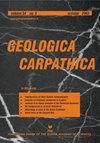Source rock potential of the Oligocene Menilite Formation in the Czech sector of the Subsilesian Unit (Flysch Carpathians)
IF 1.5
4区 地球科学
Q4 GEOSCIENCES, MULTIDISCIPLINARY
引用次数: 0
Abstract
The Oligocene Menilite Formation represents the most important hydrocarbon source rock in the Flysch Carpathians. The formation is laterally uniform across long distances but shows strong vertical heterogeneity reflecting changes in depositional environments, which control the source rock potential. In the Czech Republic, the Menilite Formation is subdivided into the Subchert Member (nannofossil zone NP22), Chert Member (upper NP22 to lower NP23), Dynów Marlstone (NP23) and Šitbořice Member (upper NP23 to lower NP25). The present study describes in detail the Bystřice nad Olší section in the Subsilesian Unit where all four members are exposed including the uppermost part of the underlying Frýdlant Formation (Sheshory Marls). The present Frýdlant Formation has a negligible source rock potential compared to the Menilite Formation. The Menilite Formation in the Bystřice nad Olší section has mostly “good” source rock potential, although the TOC indicates “very good” potential. The Subchert Member (average TOC: 3.6 wt. %; HI up to 505 mg HC/g TOC) and the Chert Member (average TOC: 2.2 wt. %; HI up to 790 mg HC/g TOC) are the most prolific units. Based on organic petrography and HI, the kerogen is classified as type II and I. Indications of admixtures of type III kerogen are limited to samples with low TOC contents (<1 wt. %). The Source Potential Index (SPI) of the Menilite Formation in the Subsilesian Unit of the Czech Republic is estimated as ~1.15 t HC/m2 which is comparable to SPI calculated for sections in the Silesian and Ždánice units in the Czech Republic and for the Waschberg Zone in Austria. Significantly higher SPI values estimated for the Polish and especially the Ukrainian Carpathians (up to 74.5 t HC/m2) are caused by a wider stratigraphic range, several times greater thickness and higher total organic matter content.苏西里西亚单元捷克段渐新统Menilite组烃源岩潜力
渐新统Menilite组是弗理石喀尔巴阡山脉最重要的烃源岩。地层横向上长距离均匀,但纵向上非均质性强,反映了沉积环境的变化,控制了烃源岩潜力。在捷克,Menilite组被划分为小燧石段(纳米化石带NP22)、燧石段(NP22上至NP23下)、Dynów泥灰岩段(NP23上至NP25下)和Šitbořice段(NP23上至NP25下)。本研究详细描述了Subsilesian单元的Bystřice nad Olší段,其中所有四个成员都暴露在其中,包括下伏Frýdlant组(Sheshory Marls)的最上部。与Menilite组相比,目前的Frýdlant组的烃源岩潜力可以忽略不计。Bystřice nad Olší段Menilite组烃源岩潜力为“好”,TOC值为“非常好”。分契成员(平均TOC: 3.6 wt. %;HI高达505 mg HC/g TOC)和cht成员(平均TOC: 2.2 wt. %;HI高达790 mg HC/g TOC)是最多产的单位。根据有机岩相学和HI,将干酪根分为II型和i型。III型干酪根混合物的迹象仅限于TOC含量较低(<1 wt. %)的样品。捷克共和国Subsilesian单元Menilite组的源电位指数(SPI)估计为~1.15 t HC/m2,与捷克共和国Silesian和Ždánice单元的剖面以及奥地利Waschberg带的SPI相当。波兰,特别是乌克兰喀尔巴阡山脉的SPI值(高达74.5 t HC/m2)明显较高,这是由于地层范围更宽,厚度大几倍,总有机质含量更高。
本文章由计算机程序翻译,如有差异,请以英文原文为准。
求助全文
约1分钟内获得全文
求助全文
来源期刊

Geologica Carpathica
地学-地球科学综合
CiteScore
2.40
自引率
23.10%
发文量
26
审稿时长
>12 weeks
期刊介绍:
GEOLOGICA CARPATHICA covers a wide spectrum of geological disciplines including geodynamics, tectonics and structural geology, volcanology, stratigraphy, geochronology and isotopic geology, karstology, geochemistry, mineralogy, petrology, lithology and sedimentology, paleogeography, paleoecology, paleobiology and paleontology, paleomagnetism, magnetostratigraphy and other branches of applied geophysics, economic and environmental geology, experimental and theoretical geoscientific studies. Geologica Carpathica , with its 60 year old tradition, presents high-quality research papers devoted to all aspects not only of the Alpine-Carpathian-Balkanian geoscience but also with adjacent regions originated from the Mediterranean Tethys and its continental foreland. Geologica Carpathica is an Official Journal of the Carpathian-Balkan Geological Association.
 求助内容:
求助内容: 应助结果提醒方式:
应助结果提醒方式:


